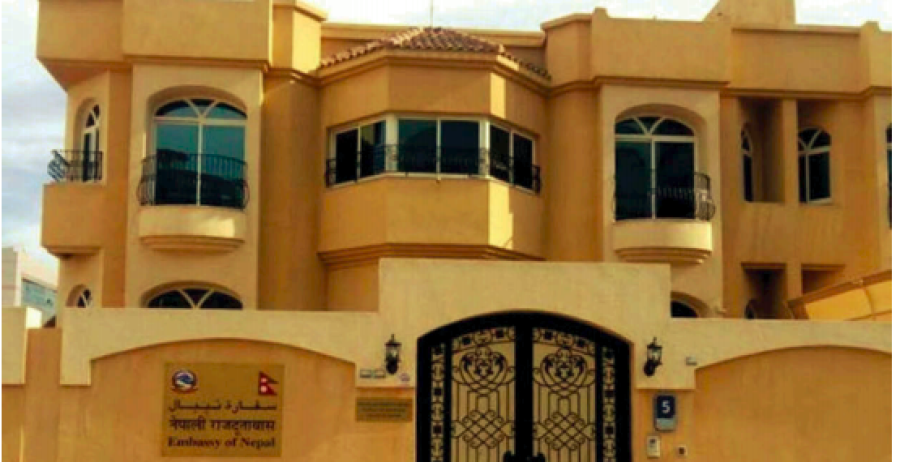National
Migrant workers do not have shelter homes in major destination countries when they need it the most
A Supreme Court decision in 2010 and existing provisions allow the government to set up safe shelter homes which could have served migrant workers even during the pandemic, says labour rights activists.
Chandan Kumar Mandal
Ramesh Budhathoki feels like he has lived through the worst point in his life.
Last September, the 38-year-old from Jhapa flew to the United Arab Emirates to work as a taxi driver, and what happened to him there drastically altered his outlook on foreign employment and the government of Nepal.
Budhathoki’s trouble started soon after he joined a taxi service company in the city of Sharjah. Thirty-nine Nepalis, including Budhathoki, had entered the company expecting a monthly pay of Rs 100,000.
“In December, the first month of the job, I received only 33 UAE dirham (around Rs 1,053) in salary. The other Nepalis were also paid around the same range,” Budhathoki said.
The second month his salary was 108 UAE dirham (Rs 3,448), still nowhere near what the company had promised.
So Budhathoki and several other Nepali workers decided to quit. They asked their company to send them home.
Little did Budhathoki and the others know that their situation was taking a turn for the worst.
Their company abandoned them after they quit and soon they found themselves struggling to pay for food and rent.
The UAE chapter of Non-Nepali Resident Association helped them with the rent payment by providing them 1,500 UAE dirham twice while they survived on food distributed by the local Nepali community and other generous people.
“We were unable to pay 6,000 UAE dirham as rent, so we had to give up one of the three rooms. There were 23 of us crammed inside two rooms, so some of us left our belongings and started sleeping in public parks and roadsides,” Budhathoki said.
In this period, the group also travelled to Nepal Embassy in Abu Dhabi, nearly two hours drive from Sharjah, for at least four times to seek help, without avail. On May 5, they even protested outside the embassy gate.
The ordeal of Budhathoki and the other Nepali workers continued for five months. They finally returned home on June 22.
Although the embassy did finally come to their aid, Budhathoki says he is not at all thankful. The insults and sufferings he and other Nepali workers endured far outweigh the embassy’s support, which came only after several rounds of visits and protests.
There are tens of thousands of Nepalis working in the Gulf states, but the Nepali missions there do not have a strong migrant workers’ welfare and safety system. Many countries do not have shelter homes for troubled Nepali citizens even though the Supreme Court has ordered the government to set up safe shelters in all the major labour destination countries.
While the Supreme Court’s order of October 2010 only talks about setting up safe shelters for women migrant workers, the existing laws that govern the foreign employment sector allows the government to open shelters for any Nepali worker facing trouble in labour destination countries, migrant rights activists say.
“Safe shelter homes are required for the protection of workers who are in trouble in foreign countries. Sometimes workers have to quit their work due to a hostile workplace environment, abusive employers, among other reasons,” said Shom Prasad Luitel, a lawyer on expertise on migrant rights. “If there is a government shelter, the workers will have a place to stay if they are facing problems. With such centres, workers don’t just find immediate relief but they can also have a recourse to justice and lodge a formal complaint against breach of their rights.”
Incidents of Nepali migrant workers losing jobs, facing exploitation and languishing without food and money are common, mainly in the Gulf countries and Malaysia.
About 95 percent of migrant workers are male, and they are often overlooked by the Nepali missions when they face troubles, because the provision of shelter homes have been set for only female workers.
“The Supreme Court decision had specifically talked about women shelter homes as it was in the petition. But we had also talked to the government officials in years to come and there was a possibility of setting up safe shelters for male workers as well,” said Luitel, who had filed the petition in the Supreme Court.
He says while the petition was filed as it seemed urgent at the time, the need for shelter homes for male migrant workers cannot be discounted.
According to Rajan Prasad Shrestha, executive director at the Foreign Employment Board Secretariat, there are shelter homes in the UAE, Kuwait, Saudi Arabia and Oman.
In countries that do not have dedicated shelters, he said the board has been sending funds to the concerned embassies whenever they need to help troubled workers.
“The embassies that do not have dedicated shelters are supposed to arrange temporary accommodations for workers until they are repatriated. The expenses are paid for by the board,” he said.
Luitel, the lawyer, said even those countries that have shelters lack basic facilities and they are poorly maintained.
The system of embassies waiting for the foreign employment board to send funds to help out a worker is clearly not working, he said. “Or else there would not have been any incidents of Nepali workers languishing in labour destination countries.”
“Workers who are facing problems can feel safe and secure even if they were to be put up in a temporary shelter.”
As per the Foreign Employment Rules, the Foreign Employment Welfare Fund can also be spent on the operation of shelters for migrant workers, but this has not happened.
Sharu Joshi Shrestha, a gender and migration expert, says the source of the problem lies at home, where political leaders and government officials are not willing to improve the situation of migrant workers.
Embassies in many labour countries still do not have shelters despite the Supreme Court’s directive, which speaks volumes about the attitude the government maintains regarding migrant workers, she said.
“Meanwhile, Nepali missions abroad have shown their reluctance in operating shelter homes saying that the local laws do not allow them to do so, even though countries like Sri Lanka and Bangladesh have been operating shelters for their citizens.”
The ongoing Covid-19 pandemic has made the necessity of shelter homes all the more important.
A recent rapid study by Nepal Policy Institute and Migration Lab found that 58 percent of respondents, who were Nepali workers employed in the Gulf region and Malaysia, were worried about getting infected due to their working conditions while 17 reported concerns about getting infected due to their living conditions.
“The pandemic has only made the workers’ condition several times worse. If there were shelters, the workers without proper working and living conditions could have found a refuge there. They would feel that their government was looking after them. But this is not happening right now,” Luitel said. “The government is simply not concerned. While it was swift to fill vacancies of labour attaché in foreign missions when ordered by the Supreme Court, it has completely overlooked and ignored the court’s order to set up shelters. This is because the ministers and officials are interested in appointing their people to plum posts. They are not interested in the concerns of common citizens.”
Budhathoki, who managed to return home after months of struggle, is disillusioned with the government and foreign employment.
“For three months we lived on the street like beggars and the government did not come to help us. If there was a shelter home for workers like us, we would not have to go through such a horrific experience,” he said. “The embassy should have done a lot more to make us feel that we were safe, that the Nepal government would take care of us, but it didn’t.”




 13.12°C Kathmandu
13.12°C Kathmandu















